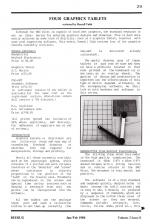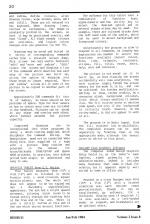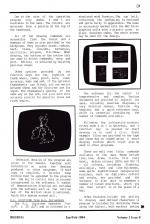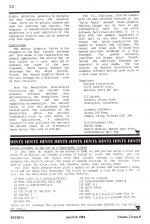
Beebug
 1st January 1984
1st January 1984
Although the BBC micro is capable of excellent graphics, the standard keyboard is not an ideal device for entering graphics designs and drawings. This is much more easily achieved by some form of digitizer, such as a graphics tablet, together with some good supporting software. This month, Russell Tubb reviews four of the graphics tablets currently available.
Introduction
Graphics tablets or digitizers are one relatively cheap and easy way of transferring freehand drawings or sketches into the computer for manipulation, storage and printing.
Nearly all those currently available work on the pantograph system, which consists of a pivoted arm with variable resistors at the 'shoulder' and 'elbow' whose resistance is directly proportional to the position of the 'hand' on the drawing area. Movements can be reproduced on the screen and special time saving routines such as drawing a rectangle from only two points can be incorporated into the software.
All the models use the analogue input port and need a calibration routine to set them up correctly (the CAD-GET is delivered already calibrated).
The useful drawing area of these tablets is just over A4 size and they all have a graticule related to that size printed on the baseboard (or in one case, as an overlay sheet). The quality of design and construction is important but the effectiveness of this type of device depends ultimately on the accompanying software. We shall look at both hardware and software in this review.
Beebplotter (Watford Electronics)
The striking thing about this model is the high quality construction. The baseboard is 40cm (16") x 48cm (19") smoked Perspex with a strong two-tone arm in similar colours to the BBC Micro. The movement is very smooth and positive.
The software ist of a high standard and responds quickly, despite being in Basic (except the infill routine), and is easy to use. A drawing is produced by a sequence of commands, which are displayed in the bottom three lines of the screen as they are entered.
Commands include: rectangle, line, circle, follow mode, print at.., move and redraw, define colours, alter drawing colour, wipe screen, save, edit and infill. These are all entered via the keyboard. When drawing lines, circles or rectangles, the shape is constantly plotted on the screen, so that it may be positioned exactly, and then 'fixed'. All eight steady colours are available, and logical colour changes also are possible (ie VDU 19).
Drawings may be saved and stored as a string of corresponding comnands rather than a straight screen dump. This allows two very useful features: 'edit' and 'move and redraw'. 'Edit' clears the screen and displays a list of the commands which describe how each step of the picture was built up, giving the option of skipping over those steps no longer required. 'Move and redraw' allows all or some of the picture to be copied to another part of the screen.
Approximately 200 commands fit into 1k of memory, so there should be few problems of space. Tips for disc owners on how to obtain more room are included in the handbook. Pictures can be saved at any stage and overlay each other, which further extends the picture capacity.
Completed drawings can be incorporated into other programs by using a short routine supplied, which deciphers the command string. The Beebplotter need not be connected when doing this. Also supplied is a tape with a picture dump routine and programs in the manual for Acorn/Seikosha GP80/GP10 and Epson MX80 printers. In practice, this system proved both simple to understand and easy to use.
Graphics Tablet (G. T. Norton)
This tablet measures 46cm (18") x 41cm (16") and is finished in white Formica with a wood coloured, square section plastic arm. The whole unit does not appear to be too rugged and has a decidedly unprofessional appearance. The arm has a slight upward movement, allowing thick books to be traced easily through the sighting hole at the free end of the arm. There is also a utility button at this end of the arm which serves several functions. The software for this tablet uses a combination of function keys, alpha-numeric and the utility key to select the desired option and at several stages either may be used. For example, there are coloured blocks down the left hand side of the tablet, which can be used to select background and foreground colours.
Unfortunately the program is slow to respond to all commands, as lengthy key depressions are needed to select the functions available (select colour, draw, line, triangle, rectangle, ellipse, fill, title, erase, abort, help, save and retrieve).
The picture is not saved as it is built up, so that clearing the screen accidentally will lose everything. The save routine simply *SAVEs the screen memory for the mode it is in, and can be retrieved for further modification. Editing is done, rather crudely, by a character sized, background coloured, block which clears anything it passes over. The fill routine supposedly works at machine code speed, but only if the background is initially black. However, on the review model, it did not appear to work at all!
The program is in Basic (apart from the fill routine) but is unLISTable. The completed screens can be used separately by *LOADing them in the appropriate mode, although the manual gives no advice on this point.
CAD-GET (Academic Software)
The Computer Aided Design Graphics Entry Tablet is, as the maker's name implies, aimed primarily at the education market. Indeed it includes many features that make it ideal for schools, but it appears equally well suited to home or office use.
Mounted on a clear Perspex base 46cm (18") x 3lem (12") with a brushed aluminium arm, each CAD-GET comes pre-calibrated, though it may be recalibrated, by software, for a different drawing area if required. It is also available as a left-handed model on request, and thumbwheels are an optional extra.
Due to the size of the operating program only modes 4 and 5 are available to the user. The colours are selected from a palette at the top of the baseboard.
All of the drawing commands are accessible from the tablet and a summary of them is also provided on the backplane. They include: erase, redraw, text, trace, line/dot, rectangle, arc/circle, polygon, fill/draw. When drawing, two buttons at the bottom left are used to select commands, move and plot. Editing is achieved by deleting previous steps.
Other options provided by the function keys are run, joystick or thumb wheel, reset, print, save, load, accuracy, mode and end. If the optional thumbwheels are fitted, you can switch between these and the digitiser arm for input. The thumbwheels operate in the same way as the arm, but give much more accurate results for parallel lines and right angles.
Technical details of the program are given in the manual, together with information on wusing the designs produced in other programs. If hard copy is required, a printer dump routine must be appended to the program but the key to control this is already incorporated in the software. A number of demonstration displays are included with the software such as the outline map of the British Isles illustrated. Again this system worked well.
P. L. Digitizer (B. S. Dollarmore)
The P.L. Digitizer measures 31cm (12") x 56 (22") and is finished in a simulated wood Formica. The top half, containing the mechanism, is enclosed and quite bulky in appearance. The base is accurately marked with the BBC micro graphics units with a plastic cover to place drawings under. The whole screen may be used for the design. The software for the tablet is comprehensive and complex. Various documents are provided to explain its uses, including exercise diagrams, a very detailed manual, function key template and a quick reference card, which is essential considering the number of commands available.
Following the calibration routine, either mode 4 or 5 is selected, and a function key is pressed to start drawing or to read a file. Eight example files are provided on the tape and these may be loaded using a short display routine which could also be used in other programs.
There are well over fifty commands available to the user. These include line, box, draw, circle, fill (very fast), define colours (GCOL and VDU 19 - all colours, including flashing, available), text and line thickness. Some quite sophisticated manipulation routines, such as duplicate, reflect and rotate, are provided and the software 1s also able to remember a number of cursor positions, which you can then return to at the press of a key.
Other features include the ability to display user-defined characters (a program is included for designing these using the tablet), halt markers making simple animation possible by delaying the next instruction, and parallel lines which can be quickly created and used for hatching and texture. The sequence of demonstration displays and animations is a good indication of the impressive results that can be achieved with this system.
Conclusions
The Norton Graphics Tablet is the cheapest of the four tablets reviewed and this shows in the construction and general appearance. The utility key on this tablet is a nice idea, but is probably the cause of the poor response, which really defeats any advantage the key might provide. Overall the Norton Graphics Tablet is the bare minimum for a digitizer, even at this low price.
Both the Beebplotter from Watford Electronics and the CAG-GET from Acedemic Software perform very satisfactorily. The Beebplotter looks very profressional and has good supporting documentation. The CAD-GET tablet is also well produced, though without quite the robustness of the Beebplotter, while the optional thumbwheels could be very useful in some applications. A compatible joystick is also available for use with the CAD-GET board as an alternative input device (the cost is £35.00).
The P.L. Digitizer, from Dollarmore with its many advanced features is the 'Rolls Royce' amongst these graphics tablets, though you do have to pay substantially more for the extra software facilities provided. It is a pity that the general appearance of this unit is not more attractive, though the solid construction may appeal to schools and colleges. The manual and other aids to using this system have been produced to a high standard. The system certainly justifies its higher price though, unless the additional features are essential to your needs, the two tablets by Watford Electronics and Academic Software provide good value at a much lower price.
This article was converted to a web page from the following pages of Beebug Volume 2 Number 8.





